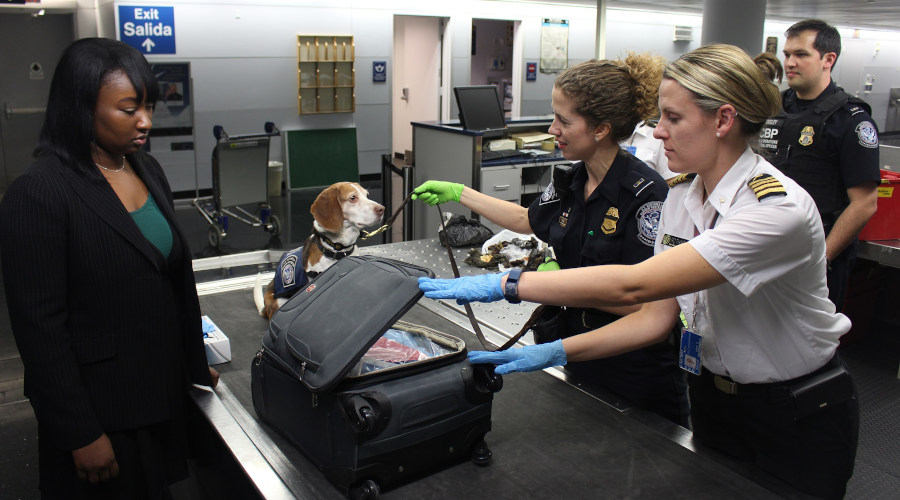There are lots of things that can trip up dog owners if they aren’t familiar with the laws in their neighborhoods, but there’s also a lot of variation from country to country and region to region. Some places make it difficult for certain breeds to be owned at all, while some may require paperwork or licenses for dogs or even restrict where people can walk their dogs.
It might not seem like much on its own, but when you add it all up, it can pose quite an obstacle to responsible pet ownership. Here’s what you need to know if you plan on bringing your furry friend with you when you travel. Don’t forget—before leaving home check out our list of travel tips you should keep in mind when going abroad with Rex.

Make sure to follow local regulations when traveling with your dog.
United Arab Emirates
In the United Arab Emirates, owning a dog is legal but importing one from abroad is not. Even if your dog was born in the UAE, bringing it into the country without special permits is still illegal. Australian shepherds and pit bulls are most likely to be affected by this law, as they’re among the breeds that are restricted from being owned entirely.
If you own a regulated breed, you’ll have to keep them on a leash at all times – otherwise, you could face over half a year of imprisonment or fines worth up to 100,000 dirhams (about $27,193.)
Dog breeding is also considered illegal; also dog walkers and dog daycare services are not allowed. Only guide dogs for the blind are permitted in public places where other dogs are prohibited.
The bottom line:
If you own a banned breed or if your dog isn’t a guide dog, you’ll have to keep them at home with a roof over their head when you’re visiting the UAE. This is one of those regions where it might be easier to leave Fido at home to enjoy his surroundings without worrying about all these laws.
If you decide to bring them with you anyways—make sure to stock up on their favorite food—it might prove difficult to find once in UAE.
Get a Free Translation Quote
Get your documents translated in advance of your travel. Click the button below:
Get a Free Translation Quote
Czech Republic
In many locations around the world, owning a pit bull terrier or any mix thereof will get you into trouble—but in some cases, there are exceptions. For example, in the Czech Republic, owning a “bull terrier type” dog is legal if it is over 15 kilograms (about 33 lbs.) The country also allows any kind of dog in public spaces unless otherwise specified by law.
However, there are certain places where no dogs are allowed at all. These include trams during peak hours and other busy transportation, trains for the general population or designated areas, and inside school buildings which elementary school students visit.
The bottom line:
Though pit bulls may be allowed, don’t expect to take your pooch on board with you when you ride the tram—and keep them away from schools and other crowded areas altogether. If you’re just visiting for a short time, this shouldn’t pose too much of an issue as long as you follow the rules.
France
In general, it’s illegal to own a pit bull terrier in France unless you have a permit for medical reasons. This includes owning any mix thereof, so pretty much everything from an American Staffordshire Terrier to a Staffordshire Bull Terrier is off-limits. However, if you owned one before this legislation was put into place, then it’s still legal for you to keep them as pets with a muzzle and leash when in public spaces.
The bottom line:
If your dog is of a banned breed or related mix, don’t bring them with you when visiting France without a permit – or authorities could confiscate them at customs.
Greece
In Greece, owning dogs is considered part of family life but certain breeds are banned. These include the American Staffordshire Terrier, Argentinian Dogo, Japanese Tosa, Fila Brasileiro, and others like them which were bred to fight in previous times.
On the other hand, places where dogs are not allowed can also be dictated by local authorities. That includes playgrounds; sports fields; beaches; patrolled swimming areas, restaurants’ terraces when food is served—or any other public space that has been deemed “at-risk” of damage due to dogs. Don’t even think about taking your dog to police stations, prisons, etc., either. That’s because law enforcement officers at all levels have the right to euthanize dogs deemed “dangerous.”
The bottom line:
If you get caught smuggling your pit bull terrier across the border, authorities will impound them and euthanize them if they feel it’s necessary. You might also get fined up to 2,500 euros (about $2,900.)
Iceland
Pit bulls are generally not allowed in Iceland under any circumstances, but this law is pretty much unenforced, given that there are less than 200 people who own these types of dogs. However, guide dogs for the blind are exempt from any kind of ban or restriction on breed while visiting public spaces like parks or beaches. The only exception is Icelandic Airports, where all dogs must be kept on leashes and muzzles.
The bottom line:
If you plan on visiting Iceland with your pitbull, you’ll have to rent a car or take public transport – and keep them leashed and muzzled at all times while out in public spaces like the beach or parks. Bring enough treats for them if they are a picky eater—pit bull specific dog food is scarce in Iceland because few people own it.
Italy
In Italy, there are no breed-specific laws but some cities do have regulations for certain breeds of dogs that come under the “potentially dangerous” category (which includes pit bulls and mixes thereof). There is also an outright ban on owning any kind of dog in Rome between March 15 and September 15 as it’s considered too hot during those months – unless you live north of Rome where there isn’t such a huge temperature difference between summer and winter.
The bottom line:
If you come to visit Italy with your pit bull, expect to have them quarantined in a government-approved kennel for ten days or so before being allowed entry into the country. Some cities do have specific laws regarding what breeds are allowed, but it’s pretty much up to each municipality to enforce these bans if they even exist at all.
Norway
Pit bulls and any mixes thereof are totally banned in Norway, including one of their most popular dog breeds—the American Bully (which is actually not recognized by AKC.) The only type of dogs that are allowed in public places like beaches, parks, etc., are those who’ve been trained as seeing-eye dogs for the blind or hearing-impaired.
The bottom line:
If you plan on bringing your American Bully to Norway with you, don’t. Leave them behind—unless they’re certified seeing-eye dogs.
Portugal
In Portugal, pit bulls and any mixes thereof are generally not allowed in public spaces like parks or beaches but if you carry the proper documentation from your vet, it’s possible for these types of dogs to visit as long as they’re muzzled and wearing a leash under control of an adult at all times when outside of a car.
The bottom line:
Don’t try smuggling a pit bull into Portugal. Even though the law is vague, authorities will seize and euthanize any banned breed that comes their way.

Don’t be surprised by regulations when you visit a foreign country. Know current laws before you go.
Scotland
In Scotland, most breeds of dogs are allowed with no specific restrictions, so pit bulls and other restricted types aren’t banned from public spaces like parks or beaches. However, they must be kept under control by a responsible adult at all times – regardless if they’re muzzled or leashed.
The bottom line:
If you plan on taking your American Bully to a Scottish beach for some fun in the sun—even though it’s not technically illegal—expect to have them seized if found running around alone—authorities will err on the side of caution as they consider this breed dangerous.
Spain
Pit bulls and their mixes are strictly prohibited from entering Spain (which includes Andorra) with laws that are enforced by both the government and private organizations. In other words, if your dog is found in Spain without proper documentation from a vet proving that it’s been neutered or spayed, then authorities will have to take them into custody until you can produce that paperwork which means they won’t be able to rejoin you until after 30 days at the very least even if you live outside the country.
The bottom line:
If you plan on flying to Andorra or Spain with your pitbull, do so at your own risk because there are no chances of being allowed entry again once turned away—not even for a day visit.
Switzerland
In Switzerland, most dogs are allowed, but only those who’ve passed some kind of certification first. The Swiss government specifically targeted pit bulls and their mixes (which includes dog breeds like the American Bulldog), which means that unless your type of dog is recognized as a working breed, they’re officially banned from an entry within the country whether you live there or not.
The bottom line:
If you try smuggling in any banned types of dogs into Switzerland, expect to face steep fines (some reaching up to 9,200 Swiss Francs) if caught doing so.
In conclusion—It’s always best practice to check with the country you’re traveling to or plan on moving to learn about any restrictions (or requirements) that may apply to your specific type of dog before planning your trip. *Please note that the regulations listed above are subject to change without notice, so always double-check with the proper authorities before doing so.



